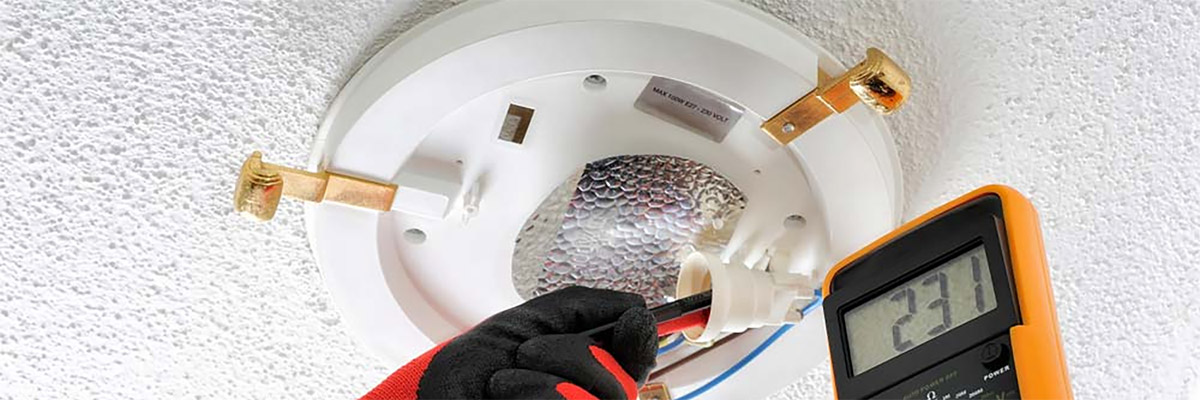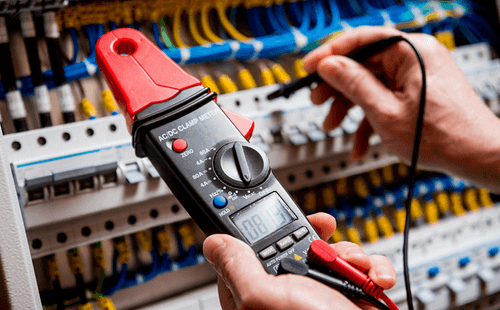Typical Electric Problems Every Homeowner Need To Know About
Property owners frequently run into different electric problems that can impact security and capability. Concerns like flickering lights and tripped breaker are extra typical than many realize. These situations can suggest much deeper electrical problems that warrant focus. Understanding the threats and signs connected with outdated electrical wiring and dead outlets is vital. What procedures can be required to protect against these troubles? Exploring these common electrical issues could reveal essential insights for maintaining a secure home atmosphere.

Flickering Lights: Reasons and Solutions
Why do some house owners experience flickering lights? Flickering lights can be a common aggravation, often suggesting underlying electrical issues. One key cause is faulty or loose connections within light components or wiring, which can cause intermittent power supply. Furthermore, utilizing high-wattage appliances on the very same circuit may cause voltage changes, causing lowering or flickering. An additional prospective problem is an overloaded circuit, where too numerous gadgets draw power concurrently, straining the electric system. Outdated or degraded electrical wiring can add to inconsistent electric flow. In many cases, flickering lights might indicate a problem with the home's electrical panel or solution line. House owners must address flickering lights quickly to avoid prospective risks. Solutions might consist of tightening up links, rearranging appliance lots, or seeking advice from a qualified electrical contractor for a thorough evaluation. Identifying the root cause can assist guarantee a secure and risk-free electrical system in the home.
Tripped Circuit Breakers: What You Required to Know
Have property owners ever wondered what triggers their circuit breakers to journey all of a sudden? This usual concern typically occurs from an overload of electric circuits, where way too many devices attract power concurrently. In such cases, the circuit breaker acts as a safety mechanism, disrupting the circulation of electrical energy to protect against overheating and prospective dangers. An additional frequent reason is a short circuit, which happens when a real-time wire get in touches with a neutral wire, creating a surge of electrical power that journeys the breaker. Ground mistakes can also bring about stumbled breakers; these take place when an online wire touches the ground or a grounded surface, posturing severe security risks. House owners ought to consistently analyze their use of high-wattage devices to prevent overloading circuits. Additionally, comprehending the feature of breaker can assist them respond appropriately throughout a journey, ensuring their home continues to be well-maintained and secure.
Outdated Electrical Wiring: Indicators and Dangers
Out-of-date electrical wiring can pose considerable dangers to homeowners, often going unnoticed up until troubles occur. Homes built before the 1980s may still have aluminum wiring or knob-and-tube systems, which are no much longer thought about safe. Signs of out-of-date circuitry consist of flickering lights, frequently tripped circuit breakers, or melting scents near electrical outlets. These indicators might recommend that the electrical system is loaded down or deteriorating.Additionally, house owners could notice blister marks around buttons or outlets, which can show getting too hot. The risk of electric fires substantially boosts with outdated circuitry, as these systems were not developed to manage modern electrical tons. House owners are urged to have their circuitry examined consistently, particularly when remodeling or adding brand-new devices. By recognizing these indicators early, they can avoid dangerous situations and preserve a more secure living environment. Upgrading to existing electrical criteria is a proactive action in preserving home security and effectiveness.
Regularly Blown Fuses: Repairing Tips
Frequent blown fuses can show underlying electric concerns that may originate from out-of-date electrical wiring or overloaded circuits. Property owners experiencing this problem needs to first recognize the home appliances connected to the influenced circuit. It is suggested to prevent making use of numerous high-wattage gadgets concurrently, as this can result in circuit overload. If the issue lingers, evaluating the circuit box for signs of wear or damages is vital; a faulty fuse box may require replacement.Additionally, looking for loosened links within the circuit can assist protect against future occurrences. Homeowners need to likewise confirm that the integrates being made use of are of the appropriate amperage, as using an inaccurate fuse can worsen the issue. If these repairing suggestions do not fix the issue, speaking with a certified electrical contractor is advised to examine the electrical system even more. Attending to these problems quickly can aid mitigate risks and assure the security of the home's electric facilities.
Dead Electrical Outlets: Usual Reasons and Solutions
When a homeowner experiences a dead outlet, it can usually be a resource of irritation and confusion. A number of usual reasons might lead to this issue. One constant culprit is a stumbled circuit breaker, which can be quickly reset. Property owners need to evaluate their electric panel to check if any kind of breakers are in the off setting. Another possibility is a faulty electrical outlet itself, which might require replacement. Additionally, loose circuitry links within the outlet can interrupt power circulation, making assessment essential.Sometimes, the issue might originate from an overloaded circuit, especially when numerous gadgets are connected. In such situations, rearranging the electric load can resolve the problem. Homeowners need to additionally think about the age of their circuitry; older systems might require updates to fulfill modern-day electric needs. If these actions do not rectify the circumstance, seeking advice from an accredited electrical contractor is advisable to guarantee safety and appropriate diagnosis.
Electric Shocks: When to Be Concerned
How can house owners figure out whether an electrical shock warrants worry? Home owners must initially analyze the severity and context of the shock. A light static shock, usually felt when touching steel things, is commonly harmless and usual. If the shock takes place while interacting with a plugged-in home appliance or outlet, it might show a much more major issue.The place and frequency of the shocks are necessary. Repetitive shocks from the very same resource, specifically in damp areas like bathrooms or kitchen areas, could signify faulty wiring or insufficient grounding. Property owners need to likewise think about the feeling of the shock; a jolt that triggers discomfort or contraction is a lot more alarming than a simple tingle.If there's any type of unpredictability, it is recommended to get in touch with a certified electrician. Ignoring prospective electrical threats can cause serious security risks, consisting of fire or serious injury.
Overloaded Circuits: Avoidance and Safety And Security Steps
Overloaded circuits posture substantial dangers in residential settings, commonly resulting in electric fires or devices damage (ASP Level 2 Electrician). Home owners must identify the indications of an overloaded circuit, such as frequently stumbled breakers or lowering lights. Implementing precautionary safety practices can help reduce these threats and ensure a much safer living setting
Identifying Overloaded Circuits
What signs suggest that a circuit may be overloaded? Homeowners should be alert for a number of essential indicators. Frequently tripped breaker or blown merges recommend extreme tons on the circuit. Dimming or flickering lights, specifically when various other home appliances are in usage, can represent a poor power supply. In addition, outlets or buttons that feel warm to the touch may suggest overheating, a prospective fire threat. Uncommon buzzing audios from outlets also call for interest, as they can indicate electric problems. Ultimately, if appliances run inefficiently or fail to start, it might be basics an indicator of an overloaded circuit. Identifying these indicators early can aid avoid serious electric problems and promote a much safer home environment.
Preventive Safety And Security Practices
To maintain a effective and secure electric system, house owners must carry out preventive safety and security techniques that deal with prospective circuit overloads. One reliable action is to avoid attaching a lot of tools to a solitary outlet, as this can go beyond the circuit's capability. Using power strips with integrated circuit breakers can help distribute power safely. Property owners need to likewise regularly check cables and devices for damages and change any damaged equipment promptly. It is important to ensure that circuit breakers are functioning appropriately and to be knowledgeable about the complete wattage being utilized in each circuit. Furthermore, consulting an accredited electrician for periodic examinations can recognize prospective issues prior to they rise, assuring a safer living atmosphere and extending the lifespan of electric systems.
Regularly Asked Concerns
Exactly how Often Should I Have My Electrical System Inspected?
Routine evaluations of electrical systems are advised every three to five years. Homeowners should think about a lot more regular checks if Get More Info they experience issues, take on restorations, or reside in older buildings to ensure security and conformity.
Can I Take Care Of Electrical Issues Myself or Hire a Specialist?

What Are the Signs of an Electrical Fire Danger?
Indicators of an electrical fire threat include often stumbled circuit breakers, flickering lights, shedding odors, stained outlets, or cozy, humming cords. Homeowners ought to continue to be watchful and seek specialist help if any one of these indicators exist.
Exactly how Do I Know if My Home Requirements an Electrical Upgrade?
To identify if a home requires an electrical upgrade, indications include frequent circuit breaker trips, out-of-date electrical wiring, inadequate electrical outlets, flickering lights, and the visibility of older electric panels, indicating potential safety dangers and ineffectiveness.
Exist Certain Safety And Security Tips for DIY Electric Job?
When considering DIY electric work, one ought to always transform off power, use shielded devices, confirm circuit functionality, adhere to regional codes, and consult professionals for complex jobs to assure security and protect against mishaps. An additional possible issue is an overloaded circuit, where also lots of tools draw power at the same time, straining the electrical system. The danger of electric fires significantly increases with obsolete electrical wiring, as these systems were not created to deal with modern-day electrical tons. Constant blown integrates can suggest underlying web electrical concerns that may stem from out-of-date electrical wiring or overloaded circuits. To maintain a risk-free and effective electric system, house owners have to implement preventative safety and security methods that resolve prospective circuit overloads. Level 2 Electrician Sydney. Indicators of an electrical fire danger include frequently stumbled circuit breakers, flickering lights, burning smells, discolored electrical outlets, or cozy, buzzing cables